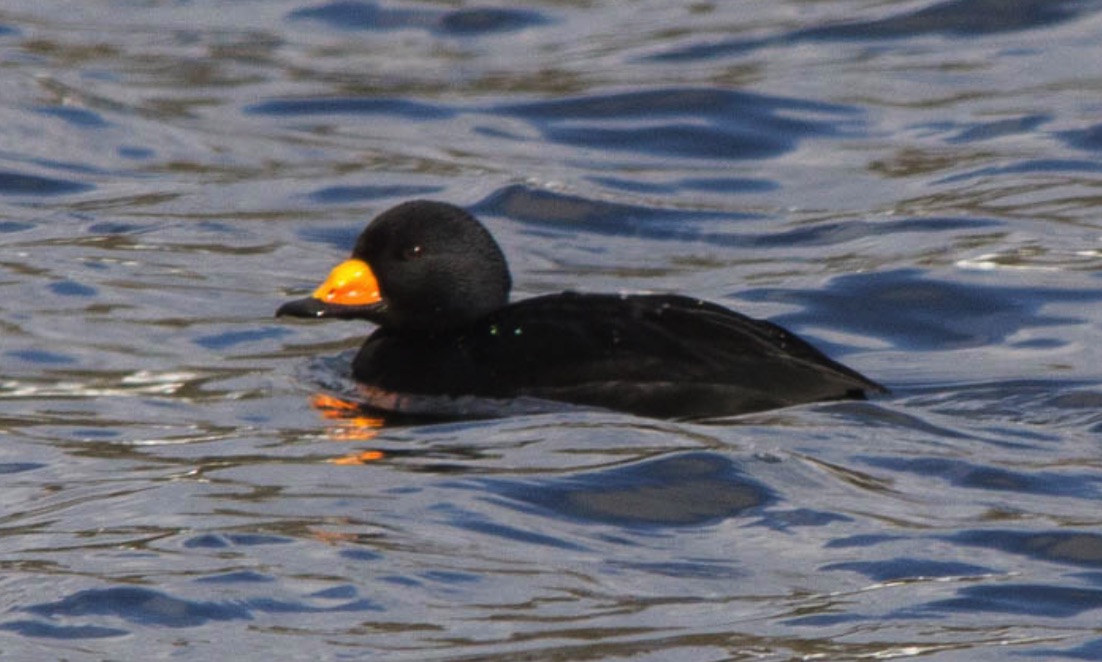
Black scoter (Americana) (Melanitta nigra americana)
Species name
- Dutch name:
- Zwarte zee-eend (Amerikaanse)
- English name:
- Black scoter or American scoter
- German name:
- Amerikanische Trauerente
- French name:
- Macreuse à bec jaune
- Scientific name:
- Melanitta nigra americana
Scientific classification
- Order:
- Anseriformes
- Family:
- Anatidae
- Onderfamilie:
- Merginae
- Genus:
- Melanitta
Description
- Description:
Male:
All black, more glossy on head, neck and upperparts then under parts. Tail all black and pointed, usually held raised. Upper wings glossy black, but undersides of flight feathers silvery grey, contrasting with sooty brown black underwing coverts: in flight shows paler rear half of underwing, darker to front. Bill all black with a orangeish yellow swollen knob, (note) giving this duck the nickname butter bill. Legs and feet are Brown-Black.Female:
Dark sooty brown on crown and hindneck, contrasting with brownish –white cheeks, throat and sides of neck, Rest of upperparts, upper wing and tail dark brown. Lower breast and belly pale brown to whitish, darker flanks barred olive –brown. Underwing as male, with grayish flight feathers contrasting with darker coverts. Bill dark olive brown to black. Bill dark olive-brown to black, lacking Knob, with variable , but always small amounts yellow on the culmen, inside of nostrils . legs and feet olive brown.Juvenile:
As female, but considerably paler on lower head and underparts, this is barred whitish. Male becomes blacker in first winter, and small patch of yellow develops around the nostrils from January; has small knob and yellow band from nostrils towards forehead by first spring not fully plumed until second winter.
Standard Measurements
- Body Length (cm):
- The male (drake) of the Black scoter (Americana) measures approximately 43-54 centimeters. The female measures approximately 43-51 centimeters.
- Body Weight (grams):
- The male will weight about 705-1270 gram. The female will weight about 705-1085 gram.
The weight is notoriously variable and can only be used as indication!
- Subspecies:
This large sea duck is also considered as a subspecies Melanitta nigra americana of the black sea duck found in Europe and West Asia.
- Note:
Black scoters are generally winter-hardy and sociable. They are preferably kept on a large area of clean, cold, deep water, at least some of which (preferably half the area) should be more than 60cm and preferably more than1m deep. As with other diving ducks, most species are relatively ungainly on land and ponds should have shallow sloping banks. Some cover along the pond edges will generally be appreciated. Preferred nesting sites vary greatly within this group, from open ground nesting to thick vegetation and tree holes.
These ducks generally need a higher-protein diet than most waterfowl species and high-protein pelleted diets specifically designed for seaducks are now available, although supplementation with fish may still be important particularly for breeding.
Feeding in troughs containing stones may avoid the development of overgrown bills. Provision of salt water may decrease the incidence of fungal and other infections.
Ducklings may be given high-protein starter crumbs and live food, and provided with access to deep water for swimming from an early age.
Scoters are not commonly kept in captivity. Cold, pure water and a high quality diet are thought to be important in their maintenance. In captive conditions they are prone to respiratory infections and particularly to fungal infections. They can be aggressive.
These ducks are bred in only a few collections. Natural close cover and open cover should be available for nesting. Eggs are normally laid May to June. Ducklings have been successfully hand reared.
Hybridisation has been reported with Eurasian wigeon (Anas penelope).
- Breeding:
- The female Black scoter (Americana) usually lays from 5-8 cream, pink-buff or pale buff eggs and incubates them for 27-31 days.
- Artificial incubating:
The ideal relative humidity for incubating most waterfowl eggs is 55% (ground nesters) and 40% (cavity nesters). The temperature is usually 37.4°C. Set ventilation as recommended by the incubator manufacturer. Eggs must be turned, either automatically or by hand, a minimum of 4 times a day. As the duckling develops there is a loss of water from the egg and the air sac gets bigger. In normal development of an egg with a 27-31 days incubation, the air sac occupies about a third of it three days earlier. Cleanliness is vital and ideally eggs should be moved to a separate hatcher at this point, where the humidity should be increased to 65% and even higher once they have pipped internally.
- Bird banding:
- Recommended closed leg band ring size for the Black scoter (Americana) is 12 mm.The leg band ring can only be applied on a young large sea duck at around 12-14 days old.
- It doesn't matter what leg that you band, but it's good to have a consistent system. Suggested: Left leg = Female, Right leg = Male
- Rearingfeed:
-

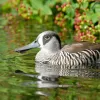

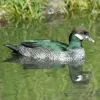
The best floatable special rearing feed from Lundi. This ideally balanced complete feed with 42% protein forms the perfect basis for the successful rearing of your ducks. The ducks grow well and have their perfect juvenile plumage after a short time.
Made exclusively from wholesome and selected raw materials, Lundi Micro 45 is also ideally suited for year-round feeding of waterfowl.
- Maintenance food:
-
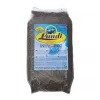
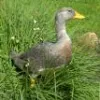



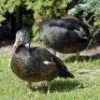
Floating high-performance feed with a unique formula and almost 100% metabolism. A special complete food for sea ducks and seabirds with the highest nutritional requirements.




Floating special complete food for sea birds with the highest nutritional requirements thanks to a particularly high protein content of 45%.
Ideal for daily feeding in animals that eat a lot of protein in their natural habitat. A must for "fish eaters".
- Regulation:
- Europese soort
- Regulation:
Het is niet verboden om deze vogels te houden die van nature in Nederland voorkomen, op voorwaarde dat deze vogels in gevangenschap zijn geboren; nakweek dus. Deze vogels zijn voorzien van een gesloten pootring. Het is wel verboden om deze vogels te houden die in het wild gevangen zijn. Alleen bepaalde instanties, zoals vogelasiels en vogelhospitalen, zijn bevoegd om jonge en gewonde wilde vogels te houden. Deze bescherming van vogels wordt vormgegeven door schadelijke handelingen te verbieden zoals:het doden, verwonden, vangen, bemachtigen en met het oog daarop opsporen van vogels (art. 9 Flora- en faunawet); het opzettelijk verontrusten van vogels (art. 10 Flora- en faunawet);het beschadigen, vernielen, uithalen, wegnemen en verstoren van nesten, holen of andere voortplantings- of vaste rust- of verblijfplaatsen van vogels (art. 11 Flora- en faunawet);en het zoeken, rapen, uit het nest nemen, beschadigen of vernielen van eieren van vogels (art. 12 Flora- en faunawet).

